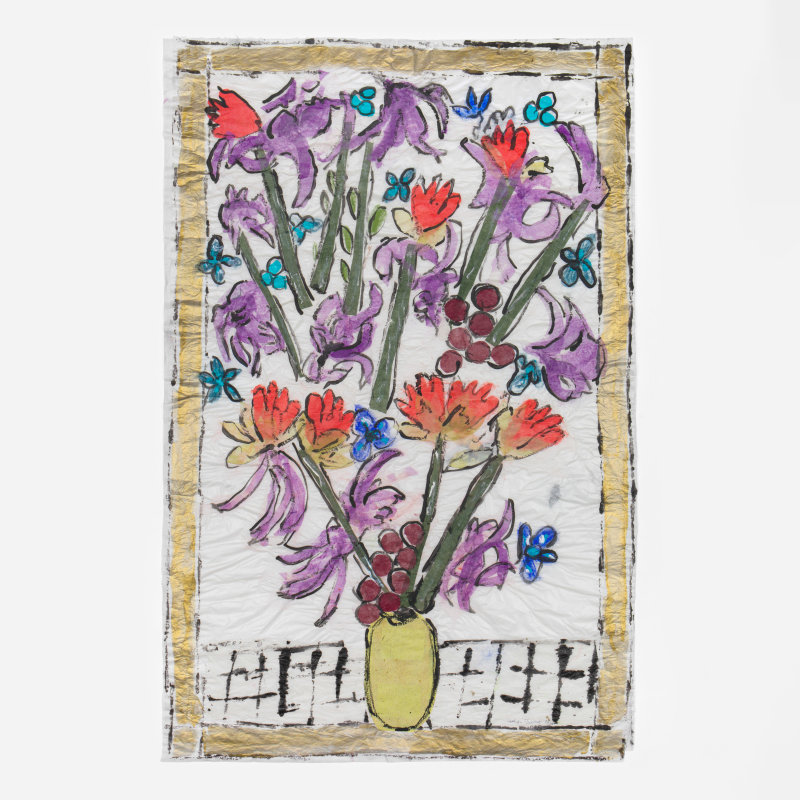Following her acclaimed solo exhibition Profusione at Le Consortium, Dijon, Isabella Ducrot presents her latest series, expanding on the body of work debuted in Remembering flowers, at Sadie Coles HQ Bury Street in 2024. Titled Profusions, the presentation will be on view in the Sadie Coles HQ Kingly Street Viewing Room until 15 February 2025.
An artist is an artist. She witnesses, spellbound, what she is capable of doing. She is a faithful witness of what she is.
– Isabella Ducrot, 01 January 2025
This series of works on paper, Profusions, can be traced back (in appearance) to a classification of “still life”: Isabella Ducrot represents an object dear to the genre, the “flower vase”. This is the undisputed protagonist of the work, at the centre of the sheet, yet everything is composed from its outline and articulated in its function until it expands and dilates to the maximum what the vase contains. The crucial distance with the idea of still life lies precisely in this dilation, because in Profusions the contents of the vase – branches and twigs of leaves and flowers – take over and leave no escape to the concord between the geometric shapes of the container and the innumerable enchanting shapes of nature. There is an extreme and dominant vitality of the flowers, which appear not to be subject to the harsh law of experience that waits for them to fade, once cut, and sanctions their poignant fleetingness. Isabella’s flowers do not make manifest the limits of time; though collected in a vase, they are not tamed and indeed partake of a disproportionate desire for life. Profusion is that which has no balance in number and size, and it is at the same time an act of generous dispersion of beauty, ornaments, and suggestions, expressing a surreal and not at all melancholic vocation for quantity. Here is where the vase blurs and becomes a tiny point of departure. It tends to disappear, letting the utterly uncomposed composition take over the surrounding space until it almost collapses along the borders of the Gampi paper sheets.
I would say that Profusions is still life in reverse. There are no limits to the composition of beauty, to the richness of what is alive, because the end of life is but a misdirection, because death, as Isabella states in Monica Stambrini’s film, is the real scandal. And if that is true, then let us not set boundaries to the profusion of beauty. There is no certainty other than the desire for more and more, beyond the here and now. Contemplating an orderly proportion of elements is therefore not allowed: everything is in motion, the representation of flowers becomes a metaphor for the mystery of desire, of the coexistence between human and divine, between pain and happiness.
I would gladly venture to say that these works are a kind of self-portrait, a kaleidoscopic representation of the most authentic inner self, a narrative which is in harmony with what emerges from Stambrini’s film. Calculations, measurements, numbers, the logic of addition or subtraction are not of this world. The one and only rule is not to stop loving what you love, desiring what you desire, suffering pain, being surprised by the possible combinations of existence.
It is possible to draw a straight line from this feeling of profusion represented by Isabella to her reflection on, and affection for, the concept of “conatus” in Spinoza’s thought, which too is mentioned in the film. In a passing dialogue with the director, Isabella reveals that she is increasingly aware that the true mystery of life, finite as it is, is to be found in the desire to persevere in living, which is what Spinoza refers to as “resistance to death”, and that is a quality that belongs to all living beings, so that the perception of life itself is a source of pure happiness. Death is a scandal, and sublimating death is a useful but somewhat jarring exercise in front of the evidence that all that lives only wants to persevere in such happiness, and it is through this process that the concept of divine becoming finds its place in the world.
– Nora Iosia
Isabella Ducrot (b. 1931, Naples, Italy) has exhibited internationally since the mid-1980s, including at the Venice Biennales of 1993 and 2011. Recent solo exhibitions include Remembering flowers, Sadie Coles HQ, London (2024); Profusione, Le Consortium, Dijon (2024); La Bella Terra, MAXXI, Palazzo Ciampoli, Taormina (2023); other things, Sadie Coles HQ, London (2023); and La Bella Terra, Villa San Michele, Capri (2023). Her work has been included in numerous recent group shows, including Women artists. Paths in graphics from the twentieth century to today, Central Institute for Graphics, Rome (2023); Super Super Markt, Berlin (2023); The Drawing Centre Show, Le Consortium, Dijon (2022); Art and Nature, Museo Carlo Bilotti Aranciera di Villa Borghese, Rome (2021); Painting Stone, Fondazione Dino ed Ernesta Santarelli, Villa Lontana, Rome (2021); Io dico Io – I say I, Galleria Nazionale, Rome (2021); and Silent Transformations, BID21ART Biennale, Internazionale Donna, Trieste (2021). She is the author of numerous philosophical and art-historical essays, including the books Twenty-Two Places of the Soul (2022), Women’s Life (2021) and The Checkered Cloth (2019) all published by Quodlibet. In January 2023, the publishing house released a new catalogue, entitled Isabella Ducrot: Stoffe (Isabella Ducrot: Fabrics), an in-depth anthology of the artist’s exquisite collection of rare fabrics amassed over the course of her lifetime; presenting two hundred and fifty-two fabrics that originate from across four continents. Ducrot’s work is held in numerous public collections including Astrup Fearnley Museum, Oslo; Galleria Nazionale d’Arte; Moderna e Contemporanea, Rome; MAXXI – Museo nazionale delle arti del XXI secolo, Rome; MAMCO, Geneva; and Le Consortium, Dijon. Ducrot lives and works in Rome.
